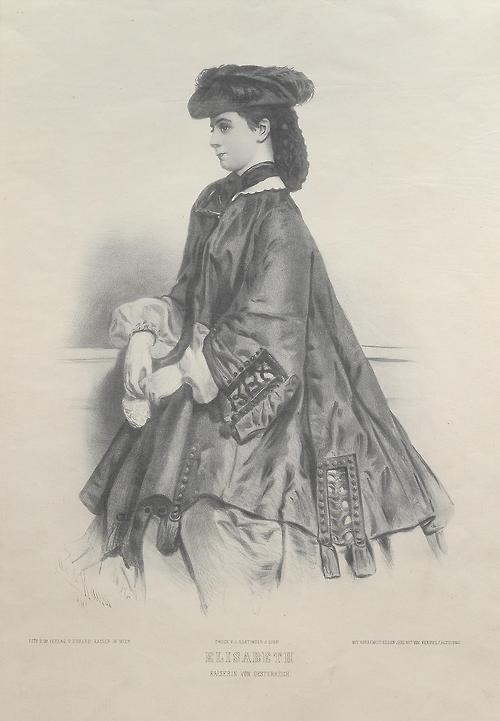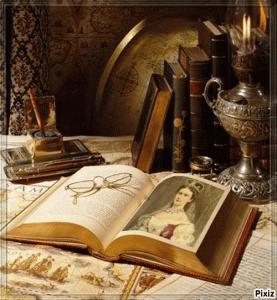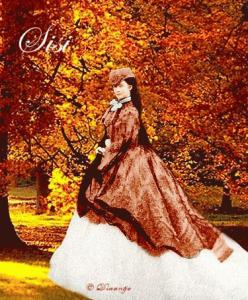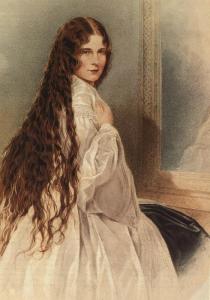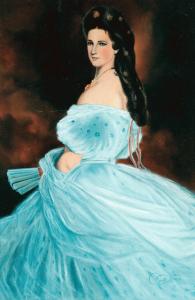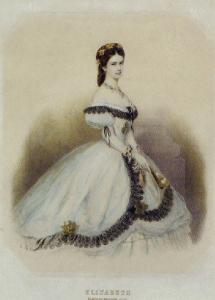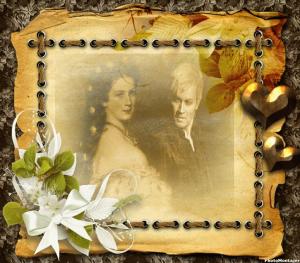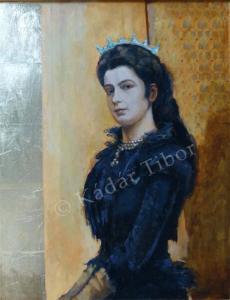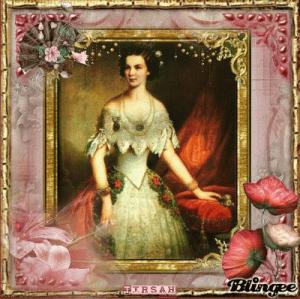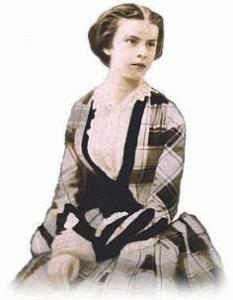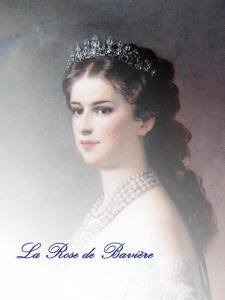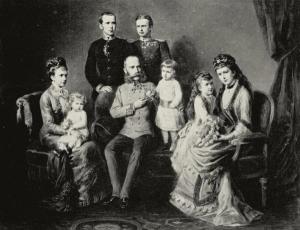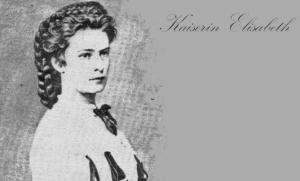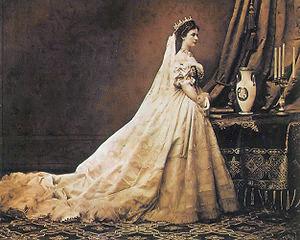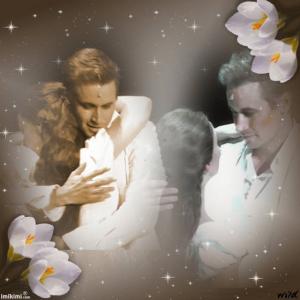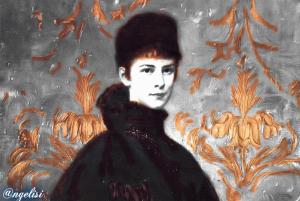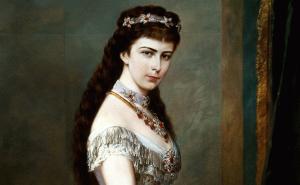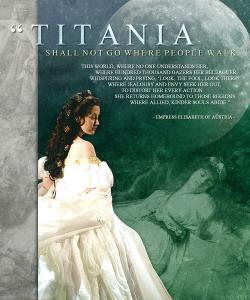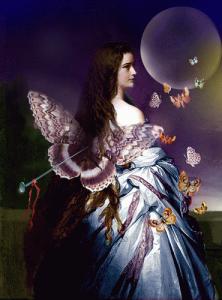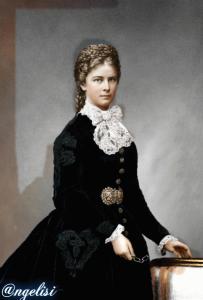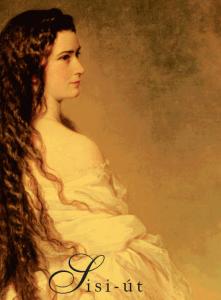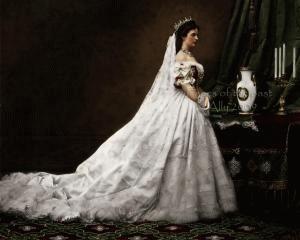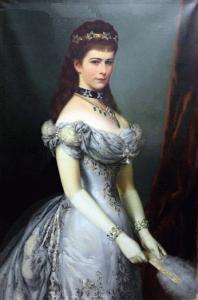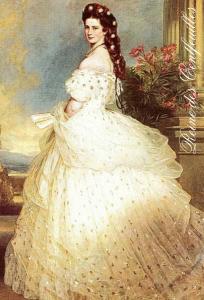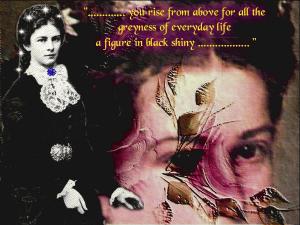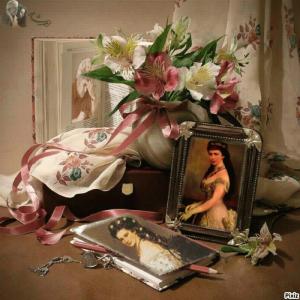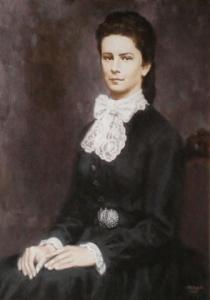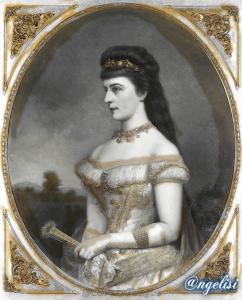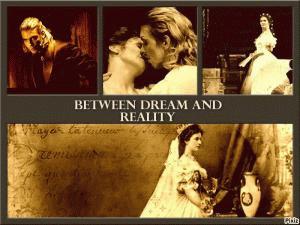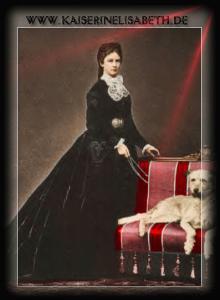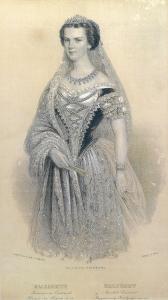Various objects, portraits, statues, ecc
From Wien to Italy : w the vienoise's valser
Fresh milk from happy cows- the Kammermeierei
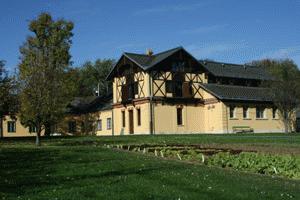
Fresh milk from happy cows - the Kammermeierei
Empress Elizabeth loved fresh milk. You just drank it from their own cows, sheep or goats. Thus Schönbrunn Palace has its own dairy farm from which the imperial family was supplied with fresh dairy products from cows from all over the world.
Elisabeth attached great importance to their diet, especially in order to maintain her slim figure into old age. At a size of - remarkable for a woman of her time - 172 cm she kept her weight even after four pregnancies and rarely took more than 47 kg to 48 kg on the scale. Important components of food prepared fresh milk and dairy products dar. That you was available fresh milk every day, special cows of different breeds were kept for the needs of the Empress. To taste, which gave the better cows milk, Elisabeth sought from animals and let them get to Vienna Inn Valley, Pinzgauer, Milan, French, Montafon, Hungary and even cattle Greek of Corfu. Also on her travels Elizabeth had often result goats and sheep with them.
To accommodate the growing crowd of ruminants Kammermeierei was established in 1895 in the former Tirolergarten of Schönbrunn Palace. The local hunters house was quickly supplemented by an annex in the barn, milk, boiling and feed room were housed. Elisabeth had a small apartment with entrance hall, toilet room and a dining room set, which was equipped with red painted and painted with floral designs furniture in the style of a Hungarian farmer's parlor in the dairy. Matching the Empress took her a snack of a service, which also shows Hungarian floral decor.
The plan was complex, which also included fertilizer and manure pit and place a guard house for ten to twelve cows and a bull. In June 1896, he hosted 26 cattle, including three bulls, and numerous chickens. Fresh products such as milk, butter, whipped cream and eggs are sent from there to the court. This of course not only the Empress was supplied, but also Franz Joseph and other family members. Therefore, the dairy was also far beyond the death of the empress in 1898 also. Also Francis Joseph "dear, good friend," Catherine Schratt was supplied with fresh dairy products. An important customer for the products from the Kammermeierei was the imperial sugar bakery. In order to provide particularly good quality, was the confectioners his order even stating the cow from which it wishes milk or cream, as these varied in quality and quite fat content.
After the end of the monarchy Kammermeierei was initially continue to operate and the income applied to the War Victims Fund.
Sonja Schmöckel
From site : http://www.habsburger.net/de/kapitel/frische-milch-von-gluecklichen-kuehen-die-kammermeierei
Hotel Kaiserin in Wien
a nice Imperial playing Cards
Dobos Torte other favourite cake of Sisi
The favourite desserts of Sisi
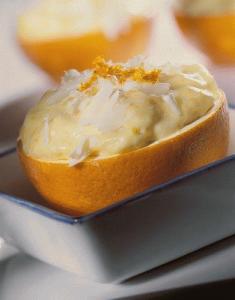
The oranges of Princess Sissi and candied violets.
This recipe is not mine, but comes from the family cookbook of Letizia Lavarini, transcribed by his mother, a friend of our group of "Gourmet Fundamentalists."Why these oranges are designed just for Sissi, the Austrian princess, I do not know how to say, especially as the favorite dessert by the wife of Franz Joseph appears to have been presnitz (these spiral (crown in our case) of puff pastry filled with chocolate and dried fruit, which is why in my mind is a Christmas cake but actually appears in each party. seems that the presnitz has been prepared for the first time by a pastry chef in Trieste during a visit to Trieste Sissi. This was the sweet awarded the first prize, or with the Prinzessin Preis: premiodella Prinicipessa, the Trieste did not understand the pronunciation of this award, the "crippled" in Presnitz and since then continues to be called so.)but the recipe in question, however, is ancient and seems to date back to 1894,"The oranges of Princess Sissi" - recipe of 1894.Ingredients: - 15 - 16 oranges - 1 liter of milk - 250 grams of sugar - 1 stick of vanilla - 10 -12 + egg yolks 2 egg whites - 100 grams of candied violetsExecution: Boil for a few minutes with 1 liter of milk 250 grams of sugar and a stick of vanilla, which you have taken care to cut in half its length. Place in a bowl 10-12 egg yolks (note: I do not know if liver transplantation is included in the recipe!), Sbatteteli with a whisk and add the boiling milk.Pour this mixture into the pan previously used to boil the milk, and stir with wooden spoon. The heat of the pan will be sufficient to mix the cream, without relight the fire. Pass the cream through a strainer into a bowl and stir until it is warm. Once cool, put the mixture in an ice cream maker and freeze you and, at the same time add two egg whites that will make your ice cream more elastic and then brillante.preparate 15-16 oranges, wash and cut a slice at the top.Candied violetsCarved out of the inside of the orange without breaking the peel. Remove the ice cream from the ice cream maker, add about 100 grams of candied violets, reserving 1/3 part for the latest outdoor decorations. Also add a tablespoon of maraschino, mix, and fill the oranges.Richiudetele with cut slice, garnish with the last candied violets. Store in refrigerator until ready to serve.From the site: http://it.paperblog.com/le-arance-della-principessa-sissi-1618400/
Presnitz a one of the cake favourite of Sisi
Empress, Queen and.......and their jewerly
FRANZ XAVEIR WINTERHALTER ............ the one who painted the soul of Sisi.
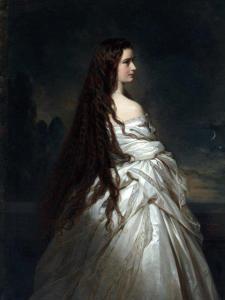
FRANZ XAVEIR WINTERHALTER ............ the one who painted the soul of Sisi.
Franz Xaver Winterhalter (20 April 1805 - 8 July 1873) was a German painter and lithographer, known for his portraits of royalty in the mid-nineteenth century. His name has been associated with fashionable court portraiture. Among his best known works are Empress Eugenie Surrounded by her Ladies in Waiting (1855) and the portraits he made of Empress Elisabeth of Austria (1865). The early Franz Xaver Winterhalter was born in the small village of Menzenschwand (now part of St. Blasien), in the Black Forest, Grand Duchy of Baden, April 20, 1805. [1] He was the sixth child of Fidel Winterhalter (1773-1863), a farmer and resin producer in the village, and his wife Eva Meyer (1765-1838), member of a family long established Menzenschwand. [1] His father was of peasant origin and was a strong influence in his life. Of the eight brothers and sisters, only four survived infancy. Throughout his life, Franz Xaver remained very close to his family, especially his brother Hermann (1808-1891), who was also a painter After attending school in a Benedictine monastery in St.Blasien, Winterhalter left Menzenschwand in 1818 at the age of thirteen to study drawing and engraving. [3] He trained as a draftsman and lithographer in the workshop of Karl Ludwig Schüler (1785-1852) in Freiburg. In 1823, at the age of eighteen, he went to Monaco of Bavaria, sponsored by Baron von Eichtal industries (1775-1850). [4] In 1825, he was granted a stipend by Ludwig I, Grand Duke of Baden (1763-1830) and began a course of study at the Academy of Fine Arts in Monaco of Bavaria with Peter von Cornelius (1783-1867) , whose academic methods made him uncomfortable. Winterhalter found a more congenial mentor in the fashionable portraitist Joseph Stieler (1781-1858). During this time, he supported himself working as lithographer Winterhalter entered court circles when in 1828 he became drawing master to Sophie Margravine of Baden, at Karlsruhe. [5] His opportunity to establish itself beyond southern Germany came in 1832 when he was able to travel in Italy, 1833-1834, with the support of Grand Duke Leopold of Baden. In Rome he composed romantic genre scenes in the manner of Louis Leopold Robert and attached himself to the circle of the director of the French Academy, Horace Vernet. On his return to Karlsruhe, he painted the portraits of the Grand Duke Leopold of Baden and his wife, and was appointed painter to the grand-ducal court. However, he left Baden to move to France where his Italian genre scene The sweet Farniente attracted notice at the Salon of 1836. Il Decameron a year later was also praised, both paintings are academic compositions in the style of Raphael. In the Salon of 1838 he exhibited a portrait of the Prince of Wagram with his young daughter. His career as a portrait painter was soon secured when in the same year he painted Louise Marie of Orleans, Queen of the Belgians, and her son, the Duke of Brabant. It was probably in this painting that Winterhalter came to the attention of Maria Amalia of the Two Sicilies, Queen of the French, the mother of the Queen of the Belgians court painter in Paris, Winterhalter quickly became fashionable. He was appointed court painter to Louis Philippe, King of the French, who commissioned him to paint individual portraits of his large family. Winterhalter perform more than thirty commissions for him. This success has earned the reputation of a painter specializing in portraits dynastic and aristocratic, skilled in combining likeness with flattery and enlivening official pomp with modern fashion. However, Winterhalter reputation in artistic circles immediately. The critics, who praised its debut in the salon of 1836, dismissed him as an artist who could not be taken seriously. This attitude persists throughout his career Winterhalter, condemning his work to a category of its own in the hierarchy of painting. Winterhalter is believed to be his first assignments as regal as a temporary interlude before returning to subject painting and the field of academic respectability, but he was a victim of its own success and for the rest of his life he would have worked almost exclusively as a portraitist. This was a field in which was not only very successful, but also made him rich. Winterhalter became an international celebrity enjoying royal patronage. Among his many regal sitters was also Queen Victoria. Winterhalter first visited England in 1842, and returned several times to paint Victoria, Prince Albert and their growing family, the painting of at least 120 works for them, a large number of which remain in the Royal Collection, on display to the public at Buckingham Palace and other royal residences. Winterhalter also painted several portraits of the aristocracy in England, mostly members of court circles. The fall of Louis Philippe in 1848 did not affect the reputation of the painter. Winterhalter went to Switzerland and worked in Belgium and England. Persistence saw Winterhalter survive from the fall of a dynasty to the rise of another. Paris remained his home until a couple of years before his death. A setback in portrait commissions in France allowed him to return to the subject painting with Florinda (1852) (Metropolitan Museum of Art, New York), a joyous celebration of female beauty inspired by a Spanish legend. In the same year his marriage proposal was rejected, and Winterhalter remained a bachelor committed to his work. After the accession of Napoleon III, his popularity grew. Since then, under the Second Empire, Winterhalter became the leading portraitist of the imperial family and the court of France. The beautiful French Empress Eugénie became a favorite model and treated him generously. Winterhalter in 1855 he painted his masterpiece: The Empress Eugenie Surrounded by her Ladies in Waiting. He set the French Empress in a pastoral meeting setting flowers in a harmonious circle with her ladies. The painting was acclaimed and exhibited the universal in 1855. Remains most famous Winterhalter. In 1852, he went to Spain to paint Queen Isabella II with her daughter, Maria, Infanta Isabel. Russian aristocratic visitors to Paris also liked to have their portraits painted by the famous master. As the "Painter of the Princes", Winterhalter was followed in constant demand by the court of Great Britain (from 1841), Spain, Belgium, Russia, Mexico, the German courts, and France. During 1850 and 1860, Winterhalter painted a series of portraits of important aristocratic Polish and Russian. In 1857, he painted the portrait of the Empress Maria Alexandrovna. During the Second Empire Mexican in 1860, led by Maximilian I of Mexico, Winterhalter was commissioned to paint portraits of the imperial couple. The consorteimperatrice Mexico, Charlotte of Belgium was the daughter of Louise-Marie of France, Queen of the Belgians, who Winterhalter painted early in his career in France. Some of the Winterhalter paintings of the Mexican monarchs still remain in their palace in Mexico City, Chapultepec Castle, the National Museum of History The past few years to deal with the pressure of portrait commissions, many of them asking for more replicas, Winterhalter made extensive use of assistants . No portrait painter ever enjoyed such an extraordinary royal patronage as Winterhalter, only Rubens and Van Dyck worked as he did in an international network. Winterhalter sought relief from the pressures of his work with holidays abroad in Italy, Switzerland and above all in Germany. Despite the many years he lived in France, he remained deeply attached to his native country. For all his success and popularity, Winterhalter continued to live simply and soberly. In 1859 he bought a villa in Baden-Baden, his favorite place to vacation. In 1864 Winterhalter made his last visit to England. In the autumn of that year he went to Vienna to execute the portraits of Emperor Franz Joseph and Empress Elisabeth that remain among his most famous works. While growing up, Winterhalter ties with France weakened while his interest in Germany grew. He was taking a cure in Switzerland at the outbreak of the Franco-Prussian War, the war that ended the Second French Empire in September 1870. After the war, the painter did not return to France going instead to Baden. E 'was officially still accredited at the court of Baden and he settled in Karlsruhe. In the last two years of his life Winterhalter painted very little. During a visit to Frankfurt in the summer of 1873 he contracted typhus and died on July 8, 1873. It was 68 years ago. Style Winterhalter came into its own as a portrait painter during the Second Empire and he painted his best work during the last two decades of his life. He matched his style to the luxury and relaxed atmosphere of the time, its hedonism and gaiety. His female models of 1850 and 1860 live in a different climate from those he painted earlier physiological, are not reticent and reserved. His male sitters inspired few original or memorable songs. Winterhalter never received high praise for his work from the serious criticism, constantly accused of superficiality and affectation in search of popularity. However, he was highly appreciated by his aristocratic patrons. The royal families of England, France, Spain, Russia, Portugal, Mexico and Belgium all commissioned him to paint portraits. His monumental canvases established a substantial popular reputation, and lithographic copies of the portraits helped to spread his fame. Winterhalter's portraits were prized for their subtle intimacy, the nature of his appeal is not difficult to explain. He created the image his sitters wished or needed to project to their subjects. It was not only skilled in placing his sitters to create almost theatrical compositions, but also was a virtuoso in the art to convey the texture of fabrics, furs and jewelery, to which he paid no less attention to the face. He painted very rapidly and very fluently, designing most of his compositions directly on the canvas. His portraits are elegant, refined, realistic, and pleasantly idealized. As for the method to work Winterhalter, you think that, as it was practiced in the design and represent figures, he painted directly onto the canvas without preliminary studies. He frequently decided the dress and pose of the character. His style was suave, cosmopolitan and plausible. Many of the portraits were copied in his workshop or reproduced as lithographs. As an artist he remained a difficult figure to place, there are few painters with whom to compare and he does not belong to any school. His early affinities were Neoclassical but his style can be described as Neo-Rococo. After his death, his painting fell out of favor being considered romantic, glossy, and superficial. Little is known about him personally and his art was not taken seriously until recently. However, a major exhibition of his works at the National Portrait Gallery (UK) in London and the Petit Palais in Paris in 1987 brought him to the forefront again. His paintings are now on display in the main European and American museums From the site: http://en.wikipedia.org/wiki/Franz_Xaver_Winterhalter
To a lunch with their Highness Franz Josef and Elisabeth
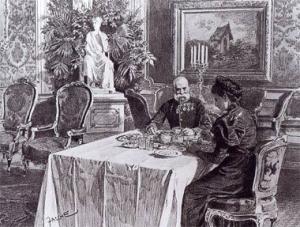
The eating habits of the Empress
Empress Elizabeth was terrified of gaining weight, although the Emperor and all the people around them were shocked by their thinness. At a height of 172 centimeters Sisi never weighed more than fifty pounds. Moreover, the Empress suffered again and again - even in the early years - to swelling (especially in the legs, ankles, face), which in turn increased their desire to meet the supposed obesity through extensive starvation. Empress Elisabeth gave way to the common meals from partly in order not with the family (or the official guests) meet - a fact which her mother, Archduchess Sophie could not understand. By their irregular and unhealthy lifestyles Elizabeth was prone to stomach cramps and catarrh, which plagued her for days. In such cases, the Empress was the food or the wine of the blame for their ailment. She had problems with their digestive and suffered - despite their joy of movement - to constipation, which again led to unwanted "weight gain". Phases in which the Empress ate with appetite, alternated with periods in which they were hungry for days or only liquid ate. Besides orange juice (Emperor Franz Joseph feared the acidity of the stomach), grape cures (Merano), meat juices and Karlovy Vary water milk and dairy products were the most popular foods of Empress Elisabeth. Already in 1867, there is evidence that the empress had prepared meat juice; daily was a calf Schlegel delivered to their room. For the production of the meat juice to let the Empress ducks presses from France get that from damage by JC Klinkosch or Berndorfer metal works were repaired or supplemented. Four of them have been preserved in the former Court Silver and Table Room. Accompanying them on their travels Hofköche and Hofzuckerbäcker had to be versed in the treatment of these specific products: "The cows are well - have enough milk so that Seitz both buttermilk, as well as butter makes of it, - this morning, we have very good pot pie had. "Because Elizabeth's passion for milk and dairy products and eggs had been so in 1895 in the Schönbrunn Kammermeierei for keeping cows and chickens. In Vienna, the food problems of the Empress were because of her unsympathetic environment particularly large. When Elizabeth appeared at official dinners, they usually took only a little broth, a piece of white bread and some fruit. She rarely drank a glass of wine. My dessert was often small pieces of ice, was dripped onto the orange juice. In later times, after the death of Crown Prince Rudolf - she took part in festive meals very rare evenings they often drank only milk. In 1866 (the war against Prussia) wrote the Emperor Franz Joseph and his wife, the appetite of the political situation: "Sisi grown very thin and has suffered a lot with me." When traveling Empress Elisabeth tried again and again, not least because of official invitations from the way to go in order to escape her unbearable compulsion to eat. "Official" on the go, not just in Vienna or in part to one-set periods in which sis refused the food completely. Empress Elisabeth had a weakness that they underlay despite slimming efforts again and again: candy. The file inventory Lord High Steward of the Empress Elisabeth Wiener House, Court and State Archives, there are numerous accounts of Demel, Gerstner, Pischinger and Gerbeaud substantiate this preference. Even after she settled Corfu Forward specialties Cabos; Sisi moved by this company include often Andrássy biscuit. She developed a special fondness for the products Antom Rumpel Mayers. A native of Upper Austria confectioner had settled on the French Riviera, where Empress Elizabeth spent a lot of time. She regularly visited the shop and bought a lot in with him. They appointed Rumpelmayer even for k.u.k. Hofzuckerbäcker. The wife Rumpel Mayers was awarded by the Empress with a brooch name cipher. Rumpelmayer was not just confectioner, he offered in his establishment also food, sometimes the Empress took their meals with him. His businesses were in Cannes, Menton, Monte Carlo and Nice. The daughter Mayers ran a lumber store in Aixles-Bains, so that the Empress herself in Savoy to enjoy their pastry had estimated. Your favorite sweets were frozen, biscuits, pretzels, and crackers. Sometimes they also ordered cakes. Among the dishes, the Empress Elizabeth also estimated, were salted pastries such as cheese cakes, onion, and Schinkenkipferl. The later the child cook cooking for Archduchess Marie Valerie, Therese Teufl prepared, especially for the so prized by Elisabeth Violet Frozen. This is extreme even Emperor Franz Joseph as follows:. "The thought of violets with Frozen orange gave me almost Übligkeiten" Empress Elizabeth was also the enjoyment of Genois cake not (similar to biscuit) averse even had their own recipes for The Empress in her France stays allocated by the Sûreté security officials confirmed: ". Elle ... marquait une Predilection pour les friandises" Sisi's preference for fresh and pastries spoke rapidly around the representatives of baker or confectioner industry. Dal sito: http://www.wien-vienna.at/sisi-essen.php
The balcony on the sea of Imperial Vienna: Opatija and Croatia. (http://www.istriadalmaziacards.com/html/collezioni_pers_dett.php?IDCat=2&IDPers=86#)
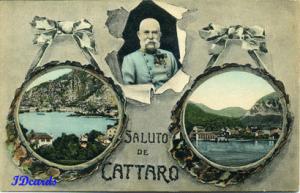
The balcony on the sea of Imperial Vienna : Opatija and Croatia.
a return to the good old days when being seen Opatija was a matter of prestige Opatija we could say many things, but wanting to be "historically honest," we mustadmit that a real history as the Pearl of Kvarner does not have: no fortprotohistoric and even remains of Roman settlements. There are even hiddenfoundations of early Christian basilicas, as even Renaissance churches. Inshort, Abbey own history does not have it and perhaps there would not have ifin 1844 the patrician Rijeka Iginio Scarpa, in order to escape from the hustleand bustle of the city, had not purchased the land belonged to the JesuitCollege to build a beautiful residence, Villa Angiolina become the symbol oftourism Opatija. We can freely say without fear of contradiction, that Abbeywould never have been if Abbey Scarpa had not decided to open the doors of hishouse to famous people who, with the system of "word of mouth", havetransformed the former fishing village in a popular tourist destination, whichin the beginning was basically the "balcony on the sea" of ImperialVienna, a balcony on which appear soon became a matter of prestige.
The holidays of Maria Anna of Savoy
The first guest was Iginio Scarpa, when the nineteenth century had just turned the ... turning point was the Croatian ban Josip Jelacic, who brought his wife Sofia. It was 1854. For him it was a peaceful retreat from the stressful life that led fromZagreb, Vienna and Budapest. In 1859 Villa Angiolina hosted the first member ofthe imperial family, the Archduke Ferdinand, and the following year he arrivednothing less than the Empress Maria Anna of Savoy, wife of Ferdinand I ofAustria, who had on December 2, 1848 abdicated in favor of Franz Joseph, whothen held the imperial crown for over 68 years. Maria Anna, who never hadchildren with Ferdinand, who was said to be mentally retarded, after thechanging of the guard moved to Prague. For Abbey spent the whole summer of 1860and during this period also reached River. He visited the St. Vitus Cathedraland the convent of Benedictine nuns, but also the Civic Hospital, after whichthey walked up the stairs of Trsat and went to the Marian shrine in accordancewith an act of devotion to the miraculous Madonna. Ferdinand died June 29,1875, while Maria Anna died May 4, 1884, when Opatija was inaugurated the firsthotel, the "Kursaal Kvarner", the current "Kvarner". MariaAnna died out definitively the main branch of the Savoy.
Ferdinand Maximilian, brother of the Kaiser
The brother of Emperor Franz Joseph, Archduke Ferdinand Maximilian, was in fact the firstmember of the Habsburg dynasty to set foot in Opatija, in August 1859, then ayear before Maria Anna of Savoy. It must be said, however, that five yearsearlier he had stayed in Veli Lošinj, where, among other things, laid thefoundation stone for the construction of the pier Rovenska. In 1858, he hadalso visited the Franciscan monastery on the islet of Cassione (Košljun), inthe Bay Bridge (Punat), on the island of Krk. Ferdinand Maximilian came to Abbey after being discharged from the army - in February 1857 was appointed Viceroy of Lombardy-Venetia, to replace the old FieldMarshal Radetzky -. With his wife Charlotte retired to private life, stayingmainly in Trieste, where together they built the castle of Miramare. With theconsent of his brother, became emperor of Mexico, but in exchange forpermission had to give up forever to the throne in Austria. His Mexicanadventure, however, ended badly, and his dream of establishing a liberalmonarchy and moderate vanished when the rebels were able to besiege the city ofQueretaro, where he had fled. Maximilian was captured and executed. The act ofexecuting Ferdinand Maximilian was reproduced on canvas by the great Frenchpainter Édouard Manet.
The Secret Life of Francis Joseph
Many celebrities went and, needless to say, who hosted them and how he wanted to spread the news of their stay in Kvarner. There is a character, however, whose visits to Abbey are surrounded by an aura of mystery. This is Emperor Franz Joseph. Officially arrived in Kvarner for the first time in 1852 to visit River, which would come again in 1869, in 1875 and 1891. In 1875 he also visited Mali. In the spring of 1894 reached Abbey to meet the German Emperor Wilhelm II, with whom dialogue villa in Jeannette (today the building houses the offices of the EnergyService), which met in 1904, also Oscar II, King of Sweden and Norway. Thelatter came down from Scandinavia accompanied by his wife and an entourage ofthirty people and stayed there for three months, so during the summer season. However, there is also a "hidden history" regarding the Emperor Franz Joseph. Indeed, it seems that the garden of Villa Madonna Emperor secretly met actress of the Burgtheater in Vienna, Katharina Schratt, which became known as "theuncrowned Empress of Austria", just as a lover and confidant of ' EmperorFranz Joseph. It seems that even in these meetings avvenissero villa Velics toVolosca. It was betrayal or escape from a turbulent love life with Elizabeth ofBavaria, who thanks to the success of the trilogy of films directed by ErnstMarischka, became famous by the name of Princess Sissi?
"Nothing, I was spared ...»
The answer is given in the Kaiser first person who, when he was announced the death of his wife - Sissi was stabbed to death in 1898 in Geneva, as he was about to board a boat, by the anarchist Luigi Italian Lucheni - said: " I was spared nothing on this earth. " In fact, the younger brother Maximilian, Emperor of Mexico,was shot by insurgents in Santiago de Querétaro in 1867, his son and heir tothe throne Rudolph died tragically during the events at Mayerling in 1889 andthe first daughter, Sophie, died in 1857 in Budapest after a visit with hisparents and younger sister Gisella, also ill with pneumonia. The nephew FranzFerdinand was assassinated in Sarajevo in 1914 in an attack that was thepretext for the outbreak of the First World War.
The heartbreak of Princess Stephanie
Rudolf of Habsburg-Lothringen, heir to the throne of the Austro-Hungarian Empire (the son of Emperor Franz Joseph and Empress Elisabeth), with his wife Stephanie of Belgium - became the first Archduchess of Austria -, spent more than once inOpatija, both before and after the opening of the hotel "KronprinzessinStephanie" (now called "Imperial"), in 1885, where the princessgave the name.Stephanie, born Princess of Belgium, Duchess of Saxony, Princessof Saxe-Coburg Gotha, was one of the first guests Abbey after it had beendeclared a health resort and health. Inscribe his name in the guestbook onNovember 27, 1891 and Abbey became an obligatory stop for her, perhaps toforget the disappointments of love. In fact, his was certainly not a marriageof love. Even before reaching his sixteenth year of age was destined to marrythe son of Emperor Franz Joseph. The negotiations for this marriage, celebratedMay 10, 1881 in Vienna, in the Church of the Augustinians, were led by theEmperor Franz Joseph, concerned to safeguard the future of the Habsburgdynasty. The couple's only daughter, however, was the Archduchess Elizabeth,born September 2, 1883 and died March 22, 1963. The marriage of Stephanie andRudolph, despite the birth of her daughter, was not particularly happy. Rodolfothen tragically died during the so-called facts of Mayerling in 1889 assiemalover, Baroness Mary Vetsera. A case of murder-suicide that was never deniednor confirmed and which represents one of the most mysterious in the history ofthe Habsburgs.
William II, Marie Antoinette ...
Speaking of Franz Joseph, we mentioned his meeting with William II, the third and last emperor of Germany, who arrived in Opatija in the spring of 1894, accompanied by his wife Augusta Victoria. The Kaiser stayed in Villa Amalia, while their children (thecouple had had seven) in Villa Angiolina. For Wilhelm II, Abbey was a"paradise on earth".The Grand DuchessMarie Antoinette of Bourbon, born Princess of the Two Sicilies and his secondwife of Leopold II of Tuscany (he was the penultimate Grand Duke of Tuscany andthe last reigning Grand Duke de facto) was in Opatija for three times, namelyin 1888, 1889 and in 1896. Adolf of Luxembourg, the last Duke of Nassau, and the fourth Grand Duke of Luxembourg, together with the Duchess Adelheid was a regular guest Abbey, staying in VillaAmalia. He arrived in the Pearl of Kvarner for the first time in 1889, while in 1901 there celebrated their golden wedding anniversary.
Carmen Sylva and her friendship with Sissi
One of the mostdistinguished guests of Opatija was certainly Charles I was proclaimed King ofRomania March 26, 1881. He arrived for the first time in 1896, accompanied byQueen Elizabeth (which used, as a poet, the pseudonym Carmen Sylva), and thenstayed there five times. During one of his regular rides through the woods, gotlost riding towards Pobri. To ensure that this does not happen again, he set upa 16 km long trail and other trails. Among the admirers of Elizabeth, indeed,Carmen Sylva, was the Empress Elisabeth, who also went to visit her in Romania.The two sovereigns later became friends and confidants. In May 1901, Charles Imet in Opatija Georgios, king of Greece. Frederick Augustus III, the last King of Saxony, came to the Abbey with Queen Anne in March 1910,on board the ship Magnet. They were so fascinated by the beauty of the Pearl ofKvarner, who returned the following year. Eleonora of Reuss-Köstritz, Empressconsort of Bulgaria as the second wife of Tsar Ferdinand I of Bulgaria, stayedin Opatija with his sons in 1914.
from: http://www.edit.hr/lavoce/2011/111105/speciale.htm
The female fashion from 1867 to 1882( From the site: http://www.abitiantichi.it/storia/1867-1882.)
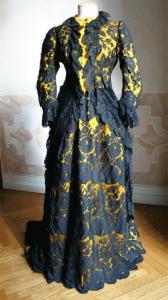
The female fashion from 1867 to 1882..
After the mammoth crinolines of the mid '60s, the measure of the skirts start to drop. It then goes to around 1867 so 'the demi-hoops and crinolines are fewer with a circumference of no more' than 4.5 meters. In short, the measures are further reduced and especially the volumes begin to move to the back. In the 70s the front of the dress falls straight focusing much of its volume on the back, enriched with drapery and arriciature and often a little train. The richness of the skirt and 'then in many cases by overlaying the skirt itself a tablier curled, and the decorations are embellished with buttons, fringes, braids, ribbons and tassels.These rich skirts, albeit to a much lesser extent total of crinolines than a decade ago, are so 'full of drapery to be required in many cases more' fabric of their ancestors. Linen and 'even as the previous two decades, and how it will be' til the end of the century, made up of several layers. First of all, a long shirt up in the middle 'thigh with a scoop neck and short sleeves, and a pair of long johns and usually open in the center. Above these a bust fence, lacing at the back and closed in front by metal hooks. The bust and 'then covered by a Camisole, ie a short buttoned shirt front, and various petticoatsThe hairstyles are rich and refined together with skirts and hats topped with loads but also extremely small. Life 'still slightly high.In the second half 'of the nineteenth century, especially after the defeat of the Paris Commune of 1870, the bourgeoisie becomes the new emerging class and espouse those instruments of social affirmation, which until then had been the exclusive domain of nobility', among them elegance. The clothes are in fact in this century a showcase of their social condition which must comply with strict rules. An elegant woman changing her clothes at least four times a day and there are specific clothes for every occasion, from dancing to the holiday, the trip to the afternoon walk.Some clothes are then reserved the house. Form of more 'simple ones to go out and line loose and more' convenient, are suitable for intimate receptions (hence the English name of tea gown that suits for you ') and can be worn without going bust. Always reserved to the walls of the case and 'the matinee', a short jacket from soft that can 'be worn on any type of skirt and and' alternative dress from home at the end of the 70s the dress loses volume the figure and 'now slim and slenderAbandoned tournure and saddles, skirts hours glide close to the body on the kidneys, and drapery and arriciature are relegated to the bottom of the skirt. Despite the vestments of apperente Ordinarily, however, 'this new line and' really 'much more' inconvenient previous 'cause tight skirts and wrapping makes it difficult to walk more' than they did and read the large cages tournure.I busts adapt to this new line and become more 'long, and so' well chignon hairstyles that are now collected in the top of the head to accentuate the verticality 'of the whole From the site: http://www.abitiantichi.it/storia/1867-1882.
The Old Photos and Posters For a Fashion to 1840 and 1869 ( from site : http://www.abitiantichi.it/collezione/fotodepoca.html#anni60 )
The Fashion Between 1840 and 1869 ( from site : http://www.abitiantichi.it/collezione.html )

The fashion between 1840 and 1869.
By 1840 the sleeves totally abandon the previous volume and become long and tight. The bodice, line fitting and more 'elongated than before, this further accentuates its verticality' ending in a point, and boat necks disappear in favor of a round neckline and saddled which often peeps a white collar.The skirts, which now again touching the ground, unlike buying volume and roundness', and to support them in their growth this comes the crinoline petticoat a stiff horsehair woven with threads of wool or silk.Socks and shoes, now completely covers them, they lose importance, but 'in this period that reappears on a low heel shoe from the tip always square and booties becoming increasingly important.The hairstyles are low with hair, ideally dark, scores on the forehead and tied back. The hats with the top frame the face often overlapping lace headphones that are almost never removed.The gloves or mittens are worn at all times, even at home.Regarding the laundry long johns are no longer straight but shaking at the ankles. E 'in this period the emergence of the armhole. An evolution sartorial essential that finally allows you to easily move your arms with tight sleeves.The jewels are a few small and discrete earrings and pendants rarely and almost never necklaces, but makes its appearance in the chatelaine belt that was hanging objects more 'diverse, from keys to the sewing kit.Towards the end of this period make their appearance hung alive even small handbags.During this period, the skirts widened dramatically reaching reach seven feet in circumference. To allow the volume to support such a stiff petticoats of the previous period are replaced by wire cages read and practices that enable greater agility 'motion despite the volume of clothes. The cages are then covered again by one or more 'petticoats of tissue to soften the forms and to give a better silhouette dress.To make room for the volume of the skirts, the life of the clothes moves up slightly. The bodice and 'though still tight and the sleeves more' common pagoda, large from the elbow down 'and worn on sottomaniche in Baptist often embroidered.The decorations more 'common geometric applications with abundant trimmings at the sleeves and bottom of the skirt.In the evening, the dance, the necklines are large and heart with very short sleeves often accompanied by equally short gloves then leave bare arms.The large amount 'of material needed to manufacture the very wide skirts makes it' often for a single skirt are packed two bodices, one day and one evening to be used alternately.After 1860 the volume of the skirt is not 'more' perfect circle around the body but moves to the rear, imbalance accentuated by a little train, and in many cases the hem does not touch more 'earth revealing shoes. This and 'obtained also thanks to raccogligonna, of partcolari clasps often silver hung to the belt via a lanyard and which were used to lift the skirt to be able to walk more' easily, for example in case of puddles.From 1864 to mark the life of a belt and the neck appears more 'common and not' more round but square.Given the inability 'to wear overcoats members about full skirts, they are replaced by all kinds of shawls or short jackets that end at the waist.That 's also the decade that saw the birth of haute couture as we know it now. Birth, which is made to coincide with the opening of the atelier in Paris in 1857 by Worth, the first fashion designer modern.From the site: http://www.abitiantichi.it/storia/1840-1866.html




